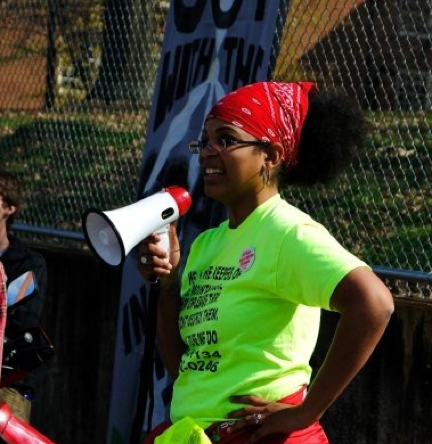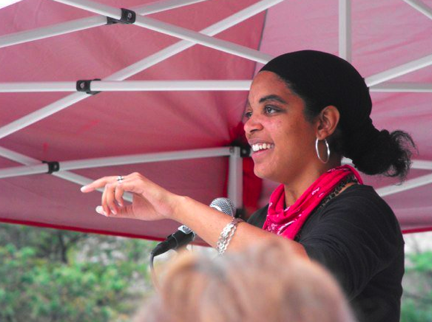"Next Steps for the Anti-Mountaintop Removal Movement" is a series of interviews with affected residents and activists in the central Appalachian coalfields region, including West Virginia leader Bo Webb, Kentuckian Teri Blanton, Kathy Selvage in Virginia, Ash-Lee Woodard Henderson in Tennessee, and Appalachian Voices legislative aide JW Randolph in Washington, D.C. While the EPA scrambles to enforce the Clean Water Act and a Republican-controlled Congress attempts to defund strip-mining regulatory measures, and various state agencies continue to be embroiled in Big Coal machinations, millions of pounds of devastating explosives are detonated daily across mountain communities in central Appalachia. As a national movement, what should anti-mountaintop removal activists do next?
Few activists have put their necks on the line as often as Tennessee activist Ash-Lee Woodard Henderson -- literally. As one of the "Kayford 8," Henderson joined other nonviolent protesters with Mountain Justice and Climate Ground Zero campaigns in the spring of 2009 in locking themselves -- and Henderson's neck -- to massive strip mining equipment on a mountaintop removal site in Boone County, West Virginia. On the steering committee of Mountain Justice and last summer's Appalachia Rising action in Washington, DC, Henderson has taken part in numerous nonviolent demonstrations, including last year's action in front of the White House.
Mountaintop removal operations in Tennessee rarely receive the same media attention as those in West Virginia and Kentucky. Despite the numerous campaigns by organizations including SOCM and United Mountain Defense, a recent effort in the Tennessee state legislature to ban mountaintop removal in that state failed this fall.
An eastern Tennessee native, Henderson credits the Civil Rights Movement and veterans for much of her activist work in Appalachia today, where she is currently a lead organizer with Chattanooga Organized for Action. Focused on issues of mountaintop removal mining, community empowerment, and environmental justice in Southern Appalachia, she is a former member of the National Council of the Student Environmental Action Coalition, among other organizations.

Henderson at mountaintop removal rally, photo courtesy of Ash-Lee Henderson
Over a half century ago, fellow Southern writer William Faulkner confronted Southerners who quietly allowed the South to "wreck and ruin itself in less than a hundred years." He begged his fellow Southerners to "speak now against the day, when our Southern people who will resist to the last these inevitable changes in social relations, will, when they have been forced to accept what they at one time might have accepted with dignity and goodwill, will say: 'Why didn't someone tell us this before? Tell us this in time?'"
Henderson has been one of the most tireless, courageous and inspiring campaigners to speak now against the day of mountaintop removal in Appalachia.
JB: Thanks to years of advocacy and actions by a growing movement, the EPA issued strict guidance rules on mountaintop removal operations last year, which EPA administrator Lisa Jackson acknowledged would end most valley fill operations. Do you think the EPA gone as far as it possibly (and politically) can in "regulating" mountaintop removal or should the EPA still be the focused of lobbying pressure?
AWH: The EPA has not gone as far as it possibly can in terms of "regulating" mountaintop removal, and if left to the coal industry, the agency will never have the political strength to do much more. The evidence is out -- Valley fills are still being permitted. For members of our movement who focus energy on lobbying, we should definitely keep up the pressure on the EPA. But, regulation of mountaintop removal isn't enough -- how do you regulate an industry that seems to have an endless amount of money to pay the fines that are given to them as punishment for breaking rules? It is time for a ban on strip-mining. The EPA cannot give us a permanent ban on strip-mining, so other federal bodies need to be pressured as well.
JB: Do you think mountaintop removal mining needs to be framed as only an environmental issue -- and thus, attracting more support from mainstream environmental organizations in DC and beyond -- or as a human rights?
AWH: The struggle to end mountaintop removal is both an environmental issue and a human rights issue. Just as I cannot be only a woman, or only a person of color, or just a working class person when I enter a room, neither can these two realities be separated when we discuss or educate folks about mountaintop removal. Framing mountaintop removal in this way allows for the opportunity to build a broader movement around this broad issue.
There is a long history of resistance and struggle and beauty in Appalachia. If we get a ban on mountaintop removal this afternoon, Central Appalachia will still struggle in a movement for sustainable, positive, social change. More and more, people in the movement to end mountaintop removal (MTR) coal mining are recognizing the intersections between forms of oppression -- racism, patriarchy, environmental injustice, and more -- and realize that banning MTR is getting rid of one of the symptoms manifested by those forms of oppression. We need to make it clear that issues about land ownership/returning the "ownership" of the mountains to the community, self-determination, labor justice, and so many others are intimately related to our struggle to end mountaintop removal.
If this is to be a legislative fight, we need anti-stripmining legislation -- a ban. We need more organizing, more people power moving to win a ban on strip-mining. We need to recognize MTR as just one symptom of how systemic oppression is affecting Appalachian people.
JB: After years of lobbying and leading protests in Appalachia and Washington, DC, where do you think the anti-mountaintop removal movement should focus its funds and energy in the next phase -- and more importantly, where should foundations and major fundraising efforts be dedicated?
AWH: I think the strength of our movement is that we have always used more than one tactic (lobbying, nonviolent direct action, community organizing), which has led to us having multiple ways for people from inside and outside the coalfields to plug in. I think we recognize that to win, to end strip mining, we must build a cohesive movement across the country, led by folks from the coalfields. I think that includes how we fund the movement. We have to spread the truth about what has and is happening that is unjust in the coalfields, educate about the long legacy of freedom fighters from Appalachia, spread the demand for a just transition, and begin the reconciliation process in Appalachia. If our movement chooses to take money from foundations or participate in other major fundraising efforts, their deliverables should be in line with that work, and we should also be prioritizing the financial sustainability of our movement by mobilizing grassroots resources.
We should also remember that if our movement is going to spend time, energy and other resources on legislative fights that the legislation that is being proposed can end or curtail many MTR valley fills, which is critically important in the process of eventually ending all MTR, but we need to be pushing for the abolition of MTR. We want the current legislation to pass, but do not want coalfield communities and their allies to think that the passage of our current legislation is the end of our struggle. We will still have to fight against strip-mining if this legislation passes until we get an all out ban on the practice.

Henderson speaks at Appalachia Rising rally in Washington, DC last summer, photo courtesy of Appalachia Rising
JB: Appalachia Rising -- an alliance of various groups and advocates -- brought more than 1,000 anti-mountaintop removal protesters to march in Washington, DC last summer, where over 100 people were arrested in front of the White House. That was 9 months ago. What has happened since, and should Appalachia Rising just be an annual event to call attention to the mountaintop removal or should it be organizing more sustained and frequent actions?
AWH: Since the conference and protest in Washington, Appalachia Rising has become a growing body of organizers from across the movement that work together on large mobilizations to call out the need for a ban on strip-mining. Kentucky Rising provided evidence that what happens with Appalachia Rising on a larger scale can happen, at home, in our states.
Currently the Appalachia Rising movement is preparing for the March on Blair Mountain that will take place June 5th-11th, 2011 (www.marchonblairmountain.org). We're going to come together again and demand that MTR be stopped now, and that a large-scale clean jobs initiative be enacted so that Appalachian workers can lead the nation's economic recovery. We hope that folks will go to the website and register to join us today!
Appalachia Rising is a movement that will continue developing leaders, building movement, speaking truth to power, unifying folks within the coalfields in Appalachia and other grassroots communities who are directly affected by dirty energy industries, mobilizing folks from outside the coalfields, and more. It's so exciting to see this movement being led by folks from the coalfields. The event in DC was an opportunity for them to see the fruits of their labor -- a nationwide movement to end MTR -- and be empowered by seeing their own community members willing to risk their freedom and be arrested to end MTR. Appalachia Rising will continue that movement building work.
JB: The anti-mountaintop removal movement has become a national movement, involving mainstream citizens and environmental organizations based in Washington, DC and San Francisco and across Appalachia, direct action groups and affected coalfield residents. A similar national movement to end poverty in Appalachia -- and to end strip-mining -- took place in the 1960s, and the question was often ask: Who speaks for Appalachia? What role should affected residents in coal mining communities play in the national anti-MTR movement?
AWH: Residents in coal mining communities are leading the national anti-MTR movement. Sustainable, long-term social change in Appalachia has to be led by folks from Appalachia. They know the issues inside and out because their everyday lives are directly affected by mountaintop removal. Our movement has to continue developing and nurturing leaders from the coalfields for it to have any validity and sustainable future. Our movement also recognizes that allies from outside the coalfields have so much to offer our movement, and as long as those allies are willing to learn about the history of struggle, resistance and organizing that has taken place in the coalfields and take direction from the people whose lives are most directly affected by mountaintop removal, their support is welcomed and encouraged.
Appalachians speak for Appalachia, but now that the movement to end strip-mining has built relationships with folks across this country and across the world, many folks are repeating the stories they've heard from folks who were born and raised in the coalfields of Appalachia.
JB: The first bill to end strip-mining was introduced in 1940 by Sen. Everett Dirksen -- 70 years ago. US. Rep. Ken Hechler, from WV, introduced a bill to abolish strip-mining in 1970, and held the first hearings on mountaintop removal in 1971. Do you think it is important to maintain a citizens lobby force to push Congress, especially this current Republican-held House, to change course and abolish MTR?
AWH: Again, I think it's important to use as many relevant tactics as we can, to get as many folks as we can to stand up to those in power and say enough is enough -- ban strip-mining. We've seen that lobbying can be an empowering experience for folks from both inside and outside of the coalfields, and that lobbying can be a really important part of leadership development. I think it also critically important to continue organizing communities, and encourage direct action when it becomes necessary to hold elected officials accountable to our communities and movements. Especially with the political climate that we're now facing, the combination of these tactics throughout our movement, and our commitment to working in alliances with organizations who agree that strip-mining has to end now whenever possible, gives us the hope that we can win.
JB: Direct action -- non-violent protests and civil disobedience -- have been a driving force in the anti-strip-mining movement since the 1960s, and saw renewed interest from campaigns led by Mountain Justice and Climate Ground Zero in West Virginia in the last few years. What role should direct action -- either periodical actions or a sustained campaign -- play in the future?
AWH: I think Appalachia Rising is setting an important standard when it comes to direct action as a tactic in our movement -- they should be actions led by coalfield residents. That's what made Kentucky Rising so empowering -- seeing folks from the hollers of Kentucky standing up and speaking their demands was a great moment. When folks from outside the coalfields participate in these actions, it's pretty easy for folks who oppose our movement's call to end strip-mining to question why they participated or to tell them to go home, but when a local person standing up for their own interests and the interests of their community participates it becomes much more difficult to discredit their motives and credibility. Appalachians know what's needed for their communities and as long as they are making the call for there to be direct action because they see it as being strategic and moving us toward winning this struggle, this tactic should continue to be used.
JB: Strip-mining takes place in 24 states, including new proposals in the endangered Cook Inlet in Alaska, the Shawnee National Forest in southern Illinois, and wilderness areas near Bryce National Park in Utah. As you know, Sec. of Interior Ken Salazar just green-lighted strip-mining operations in Wyoming that will produce 750 million to 2 billion tons of coal -- several times the annual production of all Appalachia. Why should a national anti-mountaintop removal movement only lobby to halt mountaintop removal in 4 central Appalachian states, and not other affected regions?
AWH: The anti-MTR movement in Central Appalachia has been having more and more conversations about what solidarity between themselves and other affected communities can look like, how we can win in Central Appalachia without simply shifting burden to other communities, etc. The time to build national solidarity against mountaintop removal is now, but that doesn't mean giving up our lobbying efforts to bring attention specifically to Central Appalachia. It means being intentional in our national strategy to include the voices and concerns of these other communities, attempting to find times where we can come together and raise our voices against strip-mining. It requires us saying in our messaging that we aren't attempting to build a movement that only benefits us and creates more burdens for others. It includes calling for the abolition of all strip-mining. The movement in Central Appalachia is excited about building relationships and solidarity with other affected communities and to eventually win a ban on strip-mining nationwide because of our coming together.
